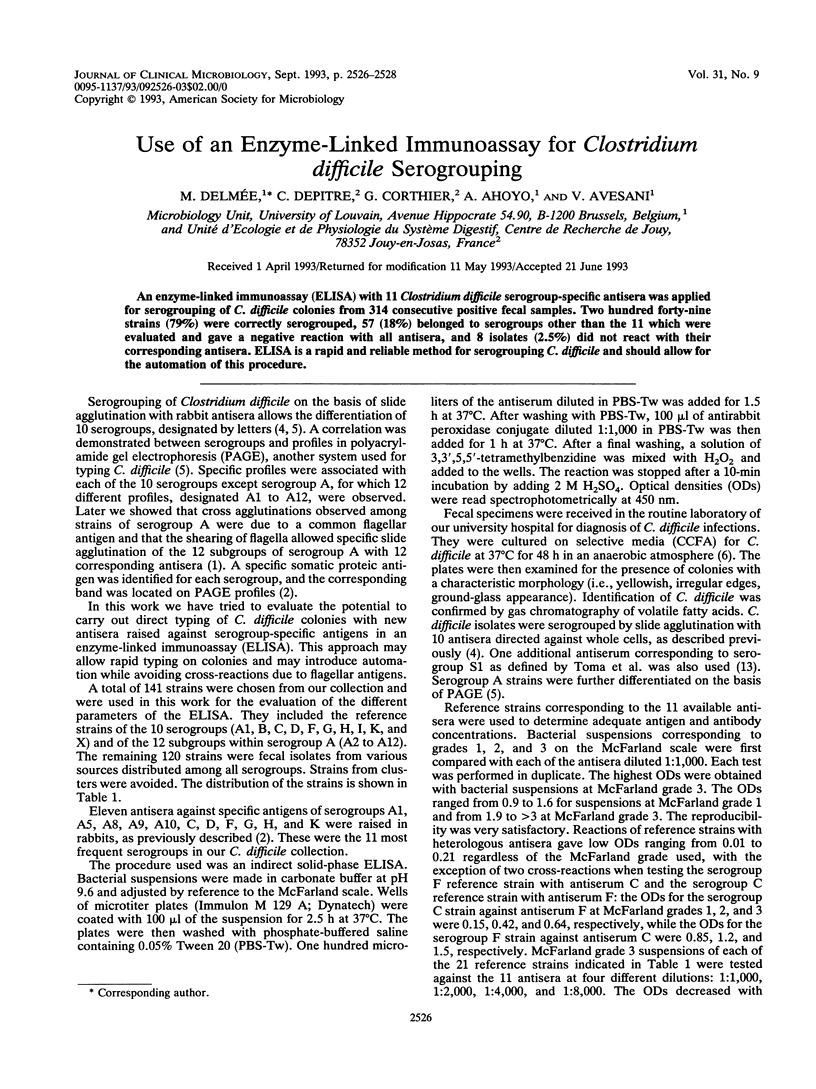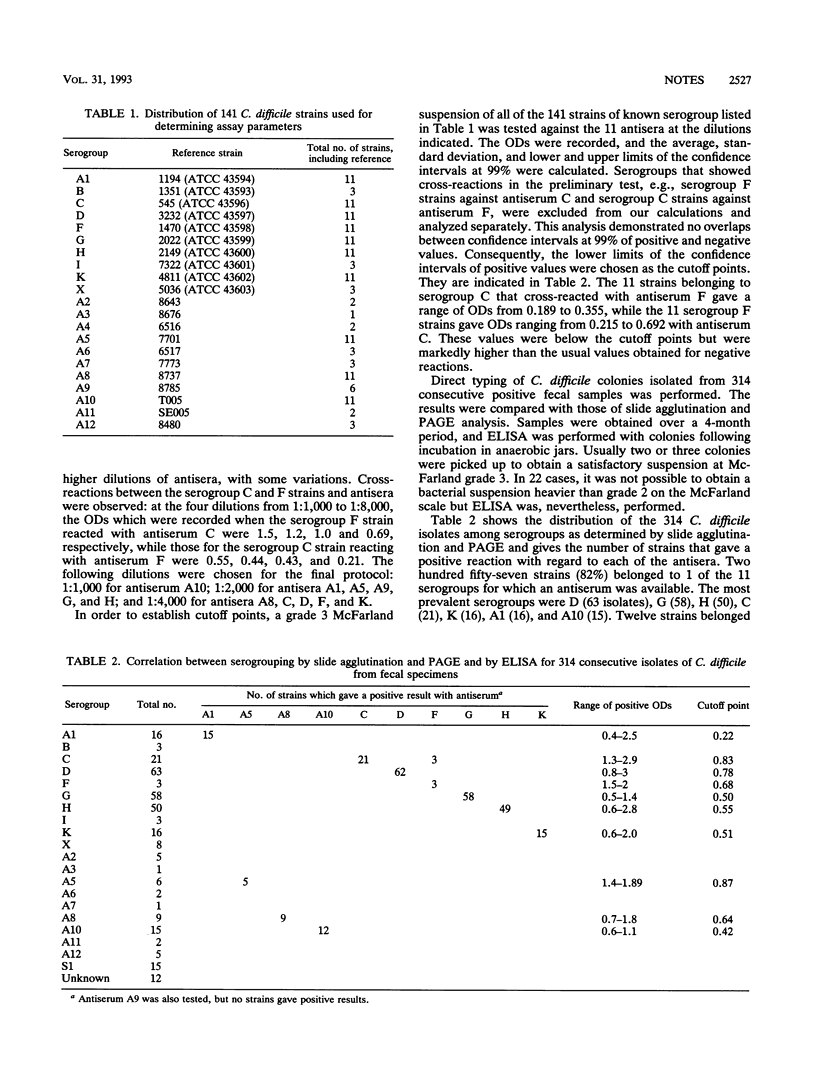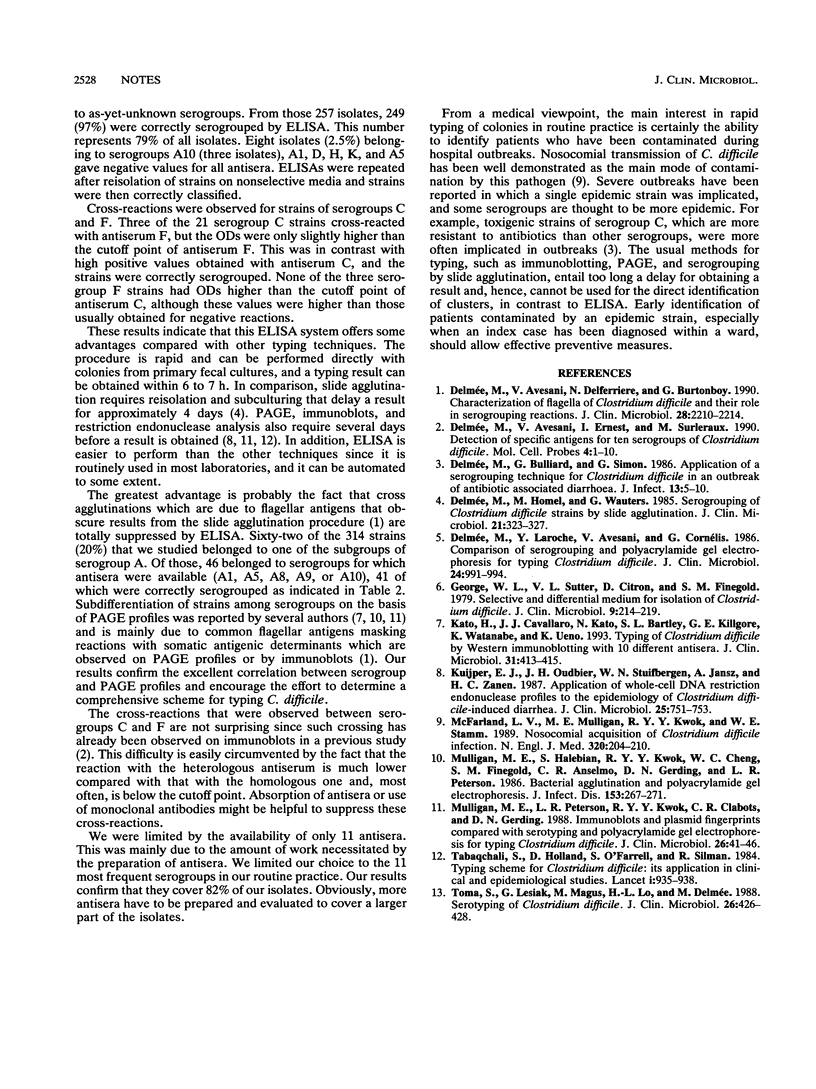Abstract
An enzyme-linked immunoassay (ELISA) with 11 Clostridium difficile serogroup-specific antisera was applied for serogrouping of C. difficile colonies from 314 consecutive positive fecal samples. Two hundred forty-nine strains (79%) were correctly serogrouped, 57 (18%) belonged to serogroups other than the 11 which were evaluated and gave a negative reaction with all antisera, and 8 isolates (2.5%) did not react with their corresponding antisera. ELISA is a rapid and reliable method for serogrouping C. difficile and should allow for the automation of this procedure.
Full text
PDF


Selected References
These references are in PubMed. This may not be the complete list of references from this article.
- Delmee M., Bulliard G., Simon G. Application of a technique for serogrouping Clostridium difficile in an outbreak of antibiotic-associated diarrhoea. J Infect. 1986 Jul;13(1):5–9. doi: 10.1016/s0163-4453(86)92095-5. [DOI] [PubMed] [Google Scholar]
- Delmee M., Homel M., Wauters G. Serogrouping of Clostridium difficile strains by slide agglutination. J Clin Microbiol. 1985 Mar;21(3):323–327. doi: 10.1128/jcm.21.3.323-327.1985. [DOI] [PMC free article] [PubMed] [Google Scholar]
- Delmée M., Avesani V., Delferriere N., Burtonboy G. Characterization of flagella of Clostridium difficile and their role in serogrouping reactions. J Clin Microbiol. 1990 Oct;28(10):2210–2214. doi: 10.1128/jcm.28.10.2210-2214.1990. [DOI] [PMC free article] [PubMed] [Google Scholar]
- Delmée M., Avesani V., Ernest I., Surleraux M. Detection of specific antigens for ten serogroups of Clostridium difficile. Mol Cell Probes. 1990 Feb;4(1):1–10. doi: 10.1016/0890-8508(90)90034-w. [DOI] [PubMed] [Google Scholar]
- Delmée M., Laroche Y., Avesani V., Cornelis G. Comparison of serogrouping and polyacrylamide gel electrophoresis for typing Clostridium difficile. J Clin Microbiol. 1986 Dec;24(6):991–994. doi: 10.1128/jcm.24.6.991-994.1986. [DOI] [PMC free article] [PubMed] [Google Scholar]
- George W. L., Sutter V. L., Citron D., Finegold S. M. Selective and differential medium for isolation of Clostridium difficile. J Clin Microbiol. 1979 Feb;9(2):214–219. doi: 10.1128/jcm.9.2.214-219.1979. [DOI] [PMC free article] [PubMed] [Google Scholar]
- Kato H., Cavallaro J. J., Kato N., Bartley S. L., Killgore G. E., Watanabe K., Ueno K. Typing of Clostridium difficile by western immunoblotting with 10 different antisera. J Clin Microbiol. 1993 Feb;31(2):413–415. doi: 10.1128/jcm.31.2.413-415.1993. [DOI] [PMC free article] [PubMed] [Google Scholar]
- Kuijper E. J., Oudbier J. H., Stuifbergen W. N., Jansz A., Zanen H. C. Application of whole-cell DNA restriction endonuclease profiles to the epidemiology of Clostridium difficile-induced diarrhea. J Clin Microbiol. 1987 Apr;25(4):751–753. doi: 10.1128/jcm.25.4.751-753.1987. [DOI] [PMC free article] [PubMed] [Google Scholar]
- McFarland L. V., Mulligan M. E., Kwok R. Y., Stamm W. E. Nosocomial acquisition of Clostridium difficile infection. N Engl J Med. 1989 Jan 26;320(4):204–210. doi: 10.1056/NEJM198901263200402. [DOI] [PubMed] [Google Scholar]
- Mulligan M. E., Halebian S., Kwok R. Y., Cheng W. C., Finegold S. M., Anselmo C. R., Gerding D. N., Peterson L. R. Bacterial agglutination and polyacrylamide gel electrophoresis for typing Clostridium difficile. J Infect Dis. 1986 Feb;153(2):267–271. doi: 10.1093/infdis/153.2.267. [DOI] [PubMed] [Google Scholar]
- Mulligan M. E., Peterson L. R., Kwok R. Y., Clabots C. R., Gerding D. N. Immunoblots and plasmid fingerprints compared with serotyping and polyacrylamide gel electrophoresis for typing Clostridium difficile. J Clin Microbiol. 1988 Jan;26(1):41–46. doi: 10.1128/jcm.26.1.41-46.1988. [DOI] [PMC free article] [PubMed] [Google Scholar]
- Tabaqchali S., Holland D., O'Farrell S., Silman R. Typing scheme for Clostridium difficile: its application in clinical and epidemiological studies. Lancet. 1984 Apr 28;1(8383):935–938. doi: 10.1016/s0140-6736(84)92392-4. [DOI] [PubMed] [Google Scholar]
- Toma S., Lesiak G., Magus M., Lo H. L., Delmée M. Serotyping of Clostridium difficile. J Clin Microbiol. 1988 Mar;26(3):426–428. doi: 10.1128/jcm.26.3.426-428.1988. [DOI] [PMC free article] [PubMed] [Google Scholar]


